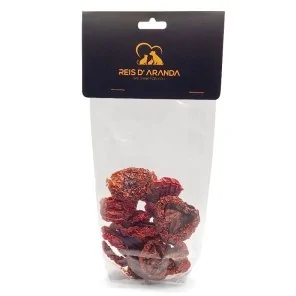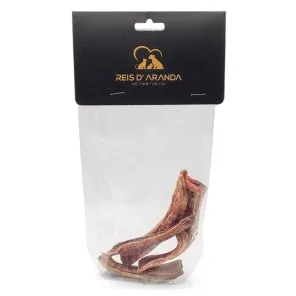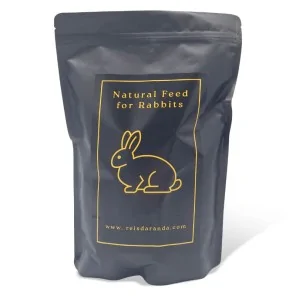Its name says it all: the Vienna blue rabbit comes from Austria. Not only is it beautiful with its shiny blue-grey...
THE TEDDY LOP DWARF RABBIT
INTRODUCTION
The Teddy Lop dwarf rabbit is one of the world's most exotic and minority dwarf breeds, a beautiful breed with a sweet personality whose population is mainly distributed in the United States, France, Spain and the Netherlands.
This breed of dwarf rabbit is one of those considered ‘endangered’ due to the few specialised breeders dedicated to it, which complicates the acquisition of good quality specimens (morphology and fur). In the United States it is a very popular breed (being known as ‘European Teddywidder’ and they themselves have developed a variant with a shorter body and greater quantity of wool using the Holland Lop, the Angora and the Lionhead, calling it ‘American Teddywidder’.
This breed is usually not very prolific and breeds when it wishes, and can have litters of between two and five litters (more is considered extraordinary and can always be accompanied by casualties). The Teddy Lop possesses the gene for dwarfism, so peanuts are possible in his litters.
THE STANDARD OF THE TEDDY LOP
The Teddy Lop (unlike many other breeds) does not have a single standard and if we read carefully the Czech, French and Spanish standards we can find more or less notable differences (especially in the subject of colour or weight). We will now look at the Spanish standard, which is one of the most complete:
TEDDY LOP SCORE TABLE:
WEIGHT: 15
TYPE AND STRUCTURE: 20
COAT (STRUCTURE): 20
COAT (DENSITY AND LENGTH): 15
HEAD AND EARS: 15
COLOUR: 10
GENERAL CONDITION: 5
TOTAL: 100
- TYPE: Muscular, deep chest and broad shoulders. Harmonious, elegant and proportionate with short, very strong legs, heavy boned. When standing, should give a rounded appearance from above.
- WEIGHT: Minimum adult weight: 1.200 kg / Maximum adult weight: 2.200 kg (ideal weight: 1.5-2 kg - the closer to 1.5 kg the better, always taking into account the size and width of the animal). There is no defined weight for rabbits under 5 months of age.
- HEAD: Well developed (especially in males), broad muzzle and full cheeks, flat face preferable (without affecting the animal's breathing). The hair of the fringe should cover the eyes.
- EARS: Broad, well covered with hair with rounded tips. The inside of the ears should not be visible from any angle. No exact length is described.
- EYES: Round and bright. Brown, blue, red, grey, split (half iris of one colour and half of another) and heterochromia (one of each colour) are acceptable. Brown with ruby or greenish sheen is permitted in shaded specimens or in those with a mixture of shading and chocolate.
- HAIR: Abundant, should be approximately 10 cm long and not less than 5 cm (the most usual length is 8 cm). Grows downwards, has a thick undercoat covered with fine but not cottony hair. Uniform and smooth. They moult between two and four times a year, it is recommended to cut the coat once a year (always with scissors). It is desirable and sought after specimens with very thick, thick and not at all cottony coat. It grows slowly and the length of the coat is less in the belly area. It is common to find specimens which have the base of the ears (the area which joins the head) and the nape of the neck slightly sparsely coated or which show a slightly poorer coat, not desirable but not to be penalised.
- COLOURS ALLOWED: All colours named in the rabbit nomenclature are permitted. Including Vienna, Witkop and Whitehead.
- CHARACTER: Independent, proud, docile and affectionate towards his family. They should not show fear or aggression towards new people. They adapt well to solitude as long as they have things to distract themselves physically and mentally. They can be sociable or indifferent to new people.
- FAULTS: Narrow shoulders, long body, narrow head. Ears drooping back or not quite drooping in adult dogs. Coat too short, white hairs on solid coloured dogs (white markings - vienna - are perfectly acceptable but loose white hairs are not desirable). Knots. Long nails, dirty ears. Borderline bite (straight incisors clashing top and bottom).
- DISQUALIFICATIONS: Excessive weight above maximum (obesity) or excessively thin for size/age, poor physical condition (clear signs of neglect). Dental malocclusion (lower teeth overlapping upper teeth). Watery, opaque or odd coloured eyes, eyes with ruby gleam in BEW specimens (blue-eyed whites), with lesions; mucousy nose. Strange bald patches. Monorchids (only one testicle or none lowered as adults) Neutered animals.
NOTE: A slight trimming of hair is permitted for hygienic reasons in the perianal area.
TEDDY LOP OR ANGORA BELIER?
Many people are confused by this term. In Spain the ‘Belier Angora’ is a non-existent breed, a name used in a commercial way to sell mongrels with floppy ears and more or less long hair, while the ‘Teddy Lop’ is the name of a pure breed whose most widespread name internationally is ‘Teddywidder’. The Teddy Lop is a very rare breed that is currently (2024) bred by less than 4 people in Spain and was introduced in the country in 2013.
If we look on French websites, for example, they refer to the breed as ‘Belier Nain Angora’ (Dwarf Angora Belier) but more and more breeders call it directly ‘Teddywidder’. In the Netherlands, the breed has its own ‘nationalised’ name which means the same thing: ‘Teddy Hangoor’.
THE SPECIFIC CARE OF THE TEDDY LOP
The Teddy Lop is a breed with a coat between 8 and 10 centimetres long when in its full glory. This type of coat is the same as that of the Teddy Dwerg (although the Teddy Lop stands out for having a more abundant and ‘fuller’ coat), possessing the M gene (mane) and the ‘L’ gene (wool), possessing both genes and not only the ‘L’ (which would result in a pure wool rabbit like the Angora) it does not require shearing unless specific conditions are met: females that have just given birth, animals removed from the show, old animals, from domestic abandonment or disabled rabbits that cannot control their sphincters or clean themselves. In the case of shearing, only the body should be sheared and the head, hands, feet and tail should be left untouched (these should be well brushed and shaped with scissors).
The Teddy Lop should be brushed every day with a stiff metal-tipped brush (especially during the moulting season) and combined with a butter brush with extra-long bristles for shows. Always apply moisturising dry sprays to keep the coat moisturised and supple, and clean the eyes every day with a small comb with narrow, close-together bristles. We should groom him from an early age, paying special attention to the throat, belly, inner thighs and hindquarters.
Some very old Teddy Lop can have a tendency to conjunctivitis even with short hair on their heads (this is especially common in albino animals), so we should check their eyes every day and, if we see any discharge or if our Teddy Lop's eye is closed, apply the eye drops recommended by our vet twice a day until the problem is solved. As for otitis, it is not a common disease in the breed and the vast majority of Teddy Lops have clean and visible ear canals; no cases of cancer have been reported in bitches to date (2024) and the average life expectancy of the breed is 9 years.
As far as feeding is concerned, it is the same as any other rabbit, being based on 80% hay, quality feed as a supplement, vegetables, occasional fruit and occasional treats.
THE TEDDY LOP AS A PET
The Teddy Lop is one of the best breeds as a pet: sociable, brave, sweet and calm. It is suitable to live with other animals and with children (always with adult supervision) and for both experienced families and beginners as long as they are committed to caring for its fur, which is a very simple routine that our rabbit will be grateful for, helping us to strengthen our bond with it.
The Teddy Lop is, along with the English Angora, one of the best breeds for animal assisted therapy, this function being especially popular in France.
CONCLUSION
The Teddy Lop is one of the most striking and beautiful dwarf rabbit breeds because of its sweet personality and lush coat, it is available in a wide variety of colours and combinations, and its small but muscular body makes it a great choice for those who want a dwarf rabbit but not a dainty one.
Leave a comment
Log in to post comments
















